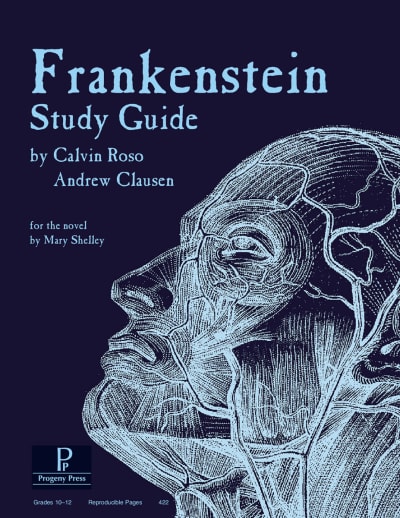Frankenstein Study Guide | Progeny Press
Description
A brilliant student, Victor Frankenstein, comes upon the knowledge of creating life. Expecting glory and hoping to benefit humanity, Frankenstein creates a man - only to discover that creation carries more consequences and responsibilities than he foresaw. The resulting tragedy speaks directly to some of the issues facing us in science and medicine today.
Years later, Robert Walton is a young man driven by his desire for knowledge and exploration - he wants to make his mark on the world. But he finds something entirely different. As the sea ice closes in on his ship, he and his crew sight a strange, gigantic being driving a dogsled across the frozen wasteland, finally disappearing into the distance. The next day they find an ill and dying man floating on a fragment of ice and persuade him to come on board for his safety. As his ship lies trapped by the surrounding ice, Walton spends many hours talking with the ill man, a Victor Frankenstein of Geneva. As they talk, Frankenstein slowly reveals his story to Walton.
Among the many companies that offer a literature guide or study guide to use with a novel, Progeny Press does a beautiful job incorporating scripture into their literary analysis. I like how their guides begin with more basic comprehension questions and evolve into more challenging questions that encourage deeper thinking. Think of it as moving from who, what and where into the how and why's. With Progeny Press, students are asked to draw comparisons between the literature they are reading and the Bible. Your student will use their own Bible in their preferred version.
New to literature study guides? They are an independent and flexible option for adding a literature component to your language arts. As your student reads a novel, the guide provides a framework, something like a workbook. The guide might suggest each learner read chapters 1 and 2, then answer some questions. Students answer directly in the guide. From a parent's viewpoint, this is a time saver! You can set a schedule if you like, or just open their guide and ask them a question! Students love talking about what they are reading, whether they like it or not. Parent educators get a sense of the investment in the book each child has based on their remarks. In addition, parents could easily develop and add some deeper questions into an essay too.
Progeny Press has many titles to choose from. The age groups overlap in places because, well, that is not an exact science, is it? One student may read a book at age 10 and another at age 14. The age groups help a parent determine if the novel's content is likely appropriate for a child's age. Reading comprehension and literary analysis are an important component of any ELA year. A typical number of novels with guides is 4-6 a year, or 2-3 per semester. Some novels may take only a couple weeks to complete, while others take up to 8 weeks. Guides are currently available as softcover books, PDF format on CD-ROM, or PDF downloads available directly from the publisher at (progenypress.com). The guides are reproducible within one classroom or family.
Each guide includes:
- a concise synopsis of the book
- information about the book's author
- background information pertinent to the story
- suggestions for activities relating to the subject matter
- introduction of literary terms
- vocabulary exercises for each section of reading
- comprehension, analysis, and application questions for each section of reading with discussion of related Biblical themes
- a complete answer key and suggestions for further reading
| Product Format: | Softcover Book |
|---|---|
| Grades: | 10-12 |
| Brand: | Progeny Press |
| Author: | Calvin Roso |
| ISBN: | 9781586093624 |
| Length in Inches: | 11 |
| Width in Inches: | 8.5 |
| Height in Inches: | 0.25 |
| Weight in Pounds: | 0.4 |

